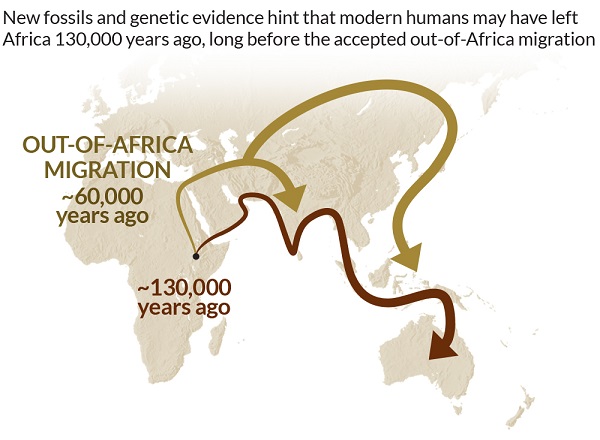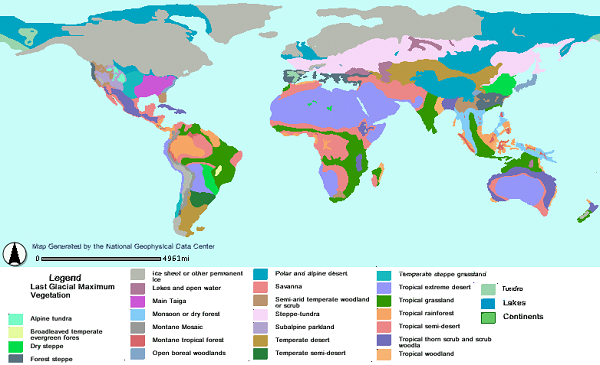Back in January 2011 I wrote about contact between Homo sapiens and Homo neanderthalensis in Neanderthals r us as modern humans moved out of Africa about 45,000 years ago. I was troubled by the lack of mention of Australian Aborigines in the article the post was based on. At the time, from memory, it was thought that Australian Aborigines had been here 10,000 years earlier than that.
Later that year genetic studies suggested that Australian Aborigines came out of Africa into Asia about 70,000 years ago, or in the range of 64,000 to 75,000 years ago. A recent New Scientist article places the consensus view at 60,000 years ago, but cites evidence of new discoveries of human fragments dating back much further. Teeth found in a cave in China date from between 70,000 and 125,000 years ago. However, scientists cannot be sure that the teeth belong to a modern human.
However, other fossils are more convincing. Bones found in Israel, including an upper jaw from Misliya cave, could be 150,000 years old. In China, Trinkaus was involved in the identification of a jawbone and two molars from Zhirendong, a cave in Guizhou province (PNAS, doi.org/fxbjgj). Though the bone is over 100,000 years old, Trinkaus’s team says the shape of its chin is suggestive of modern humans.
Now we also have this:
A closer look at the genetics also suggests there was an earlier migration. Recently, Katerina Harvati of the University of Tubingen in Germany and her colleagues tested the classic “out of Africa at 60,000 years ago” story against the earlier-exodus idea. They plugged the genomes of indigenous populations from south-east Asia into a migration model. They found that the genetic data was best explained by an early exodus that left Africa around 130,000 years ago, taking a coastal route along the Arabian peninsula, India and into Australia, followed by a later wave along the classic route (see map) (PNAS, doi.org/tz6).
Here’s the map:

Not a certainty, but definitely a possibility.
Reports of this kind seldom mention sea level. Indeed some wax lyrical about the feat of sailing from Indonesia to Australia. During the last glacial maximum, about 22,000 years ago, the sea level was some 120 metres lower. This is a vegetation map of the world back then:

During the last ice age the sea level would have varied, but clearly at times there was more land exposed to our north. Crossing would have been easier, but evidence of coastal dispersals may be now deep under water.
A time scale of 130,000 takes us back to before the Eemian, the last interglacial period.
This article also suggests a gene flow between India and Australia some 4000 years ago.
It’s a fair bet that the more we know the more complex the picture will become. There is also the small matter of the Denisovans who interbred with modern humans east of the Wallace Line, which runs between Bali and Lombok and up the east coast of Borneo.


Interesting one Brian. I have long thought that calculated rates of expansion may be much lower than actual because we don’t take account of how adventurous humans are. Think of a band that becomes obsessed with finding paradise in the land where the sun rises. Or a small group of young people escaping from conflict with older people who want to stay put. Or, people like me who really want to see what is around the next bend in the river or the next headland.
We may also be too conservative about the development of watercraft. It is a fairly basic concept that may have helped people cross the wide rivers and straights that coastal travelling people would need to cross.
John, I think one of the implications of all this is that genetically we haven’t changed very much for a very long time, and perhaps not culturally either. I’m inclined to think that humans back to 200,000 years ago were just as curious and ingenious and indulged in artistic endeavours at least in song, dance and story as any ‘modern, humans.
Brian: Many of the features of modern man are what one would expect of an “aquatic ape”. This is particularly true of women. Under these circumstances it would seem highly likely that the migration from Africa to Australia would be along a shoreline that was well below the modern one. The aridity of much of the relevant land at the time would also make the shore line a much more reliable source of food than further inland.
Well, the plot thickens.
John D. I do like your explanations of why small groups spread.
Graham: Yep. The pushing frontiers plan is not the only way spreading happens. Conflict, jealous husbands, people who marry in defiance of moity laws or prearranged marriages may want to put as much space between themselves and their old group as possible. The there are rigid hierarchies that leave a long trip as the only option for promotion.
John D,: I like your “only option for promotion”. In the days before slavery, when troublesome young men or rivals for power in a tribe or a clan could be sold off to slave traders for a handsome return – killing or expulsion were the only two options open to those in power.
The article about contact between Indians and Australians screams out a whole lot of questions.
Were the Indians Dravidian-type or were they Australoid, such as the Bhils 9India) or the Veddas (SriLanka)? Did this contact occur in Australia or in South-East Asia? How closely does this genetic evidence match the groups language in the Top End of the Northern Territory which are so different from the rest of Australia? What can dingo DNA tell us? No shortage of raw materials for fletchless arrows and simple bows, so where are they? Any evidence of artifacts or particular cultural changes (such as a name for something) spreading from a single source in the past 3750 years?
There’s another truck-load of questions just outside waiting to be unloaded. 🙂
Graham: There was considerable interaction between arrow using Torres Strait islanders and spear using Aborigines at Cape York. It shows up in both the appearance of the Cape York people and various parts of the culture.
The interesting thing is that bows and arrows, agriculture and various other things we might have thought desirable didn’t catch on. My theory was that spears may have been better at stopping kangaroos than arrows. (Particularly if we are comparing an experienced spear user vs an inexperienced bow and arrow user.)
Aborigines and Makassans were in contact with each other for a long time as a result of the trepang industry. You can see some Makkasan influence at places like Groote Eylandt but by and large the influence is very limited. My experience of Aborigines is that they are not busting their guts to be like us and what they adopt is what suits them.
My understanding is that we had a wave of immigrants with their dogs about 5000 years ago.
John D. Spears are next-to-useless in the thick New Guinea jungle but they would have been next-to-useless in dense bush here too. The spear and the non-returning boomerang were ideal for open bush and open plains. Okay, the bow-and-arrow didn’t make it into Australia – wonder if any tools, techniques or cultural items went north into New Guinea? Just wondering, that’s all.
I’m reading Yuval Harari’s Sapiens: a brief history of humankind at the moment. He doesn’t go into detail, but says that everyone east of the Wallace Line has 6% Denisovan DNA, including Australian Aborigines.
Graham: We are talking about spears with spear thrower. Worked on Groote Eylandt despite trees that were too thick for boomerangs. The spear thrower gives range and force. One advantage of spears is that it leaves one arm free to hold a shield. I have never seen it, but some Groote Eylandt Aborigines used light flexible spears that they bent when held in the spear thrower to allow the unbending to send the spear further.
There is no doubt that cape York Aborigines would have seen bow and arrows used.